Travelling to Japan? 5 spots that give breathtaking views of Mt Fuji
Planning a visit to Mt Fuji, with the several options available can get overwhelming. Here are some of the top spots where you can get the best views of the iconic peak with minimal effort.
Once upon a time, there was a farmer called Visu. He lived in Japan’s Suruga, in the central part of Shizuoka Prefecture and toiled day and night to feed his family. However, the soil was barren, which meant his family often didn’t have enough food.
One night, Visu was startled awake by a loud cracking noise.
He ventured outside to see what had happened. It was a magical sight—the massive Fujisan, or Mount Fuji, had erupted from the ground, transforming the barren land into fertile soil.
Visu called it ‘Fuji-yama’—the eternal and never-dying mountain.
Mount Fuji, to me, was prettier than its pictures.
Gazing through the scenic rural landscape, the snow-capped peak stood tall amidst the clear blue sky, waving a little hello while I looked at it.
The first glimpse of Fujisan is magical.
At the crack of dawn—jet lagged and half asleep—I got a seat on the bus that was bound to leave for Kawaguchiko. As the tall skyscrapers and the urban landscape gave way to the hills, I acknowledged the obvious: I got so lucky.
And mind you, there weren’t any cherry blossoms in the view. Summer left room for red, wide-toothed maple leaves, adding more serenity to the panoramic view.
Revered as a symbol of good fortune and well-being, the stratovolcano has inspired artists, poets, and pilgrims for centuries, and will continue to do so for generations to come.
The mountain, legends say, derives its name from "ainu," meaning fire, combined with "san," the Japanese word for mountain.
Getting there
Reaching the mountain is easy. Situated approximately 100 kilometers (62 miles) southwest of Tokyo, visitors can travel through various modes of transportation, including train, bus, and shinkansen—the famous bullet train of Japan.
While the bullet train is often preferred for its speed, traveling by bus is the most economical option, and often comes with surprising sights.
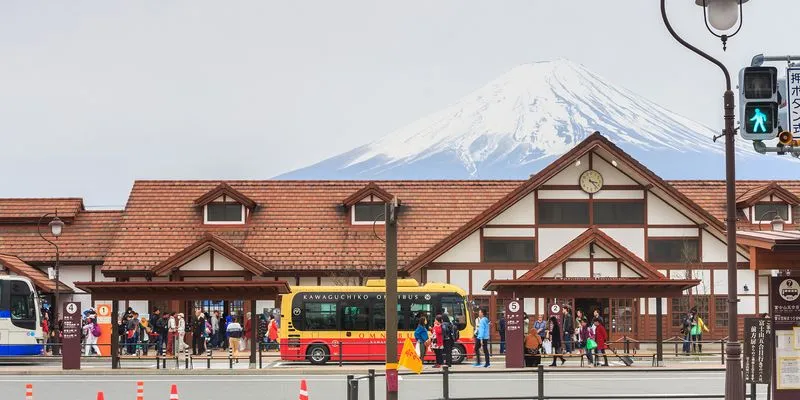
Kawaguchiko station
Adventure-seeking travellers can explore on their own, but for those who prefer sticking to the hassle-free experiences, there are several travel and experience platforms which offer English-speaking guides. The guided tours often include transportation as well, for convenience.
A sight to behold
Earlier in May, Mt. Fuji’s view from a Lawson convenience store in Kawaguchiko—one of the most scenic or Instagramable views—was blocked due to concerns over tourism and safety issues. The town installed a 20-metre-long black vinyl photo barrier to prevent tourists from gathering on the road and obstructing pedestrian pathways. And I got a chance to visit the spot just the day before this happened.
But future travellers, worry not! Here are the top alternative picks where you can still witness the mountain’s glory:
Lake Kawaguchiko
One of the Fuji Five Lakes located in Yamanashi Prefecture, Lake Kawaguchiko offers one of the best views of Mount Fuji. The views are especially lovely during cherry blossom season (mid to late April) and autumn (early to mid November), when the mountain can be seen with cherry blossoms or red maple leaves in the foreground.
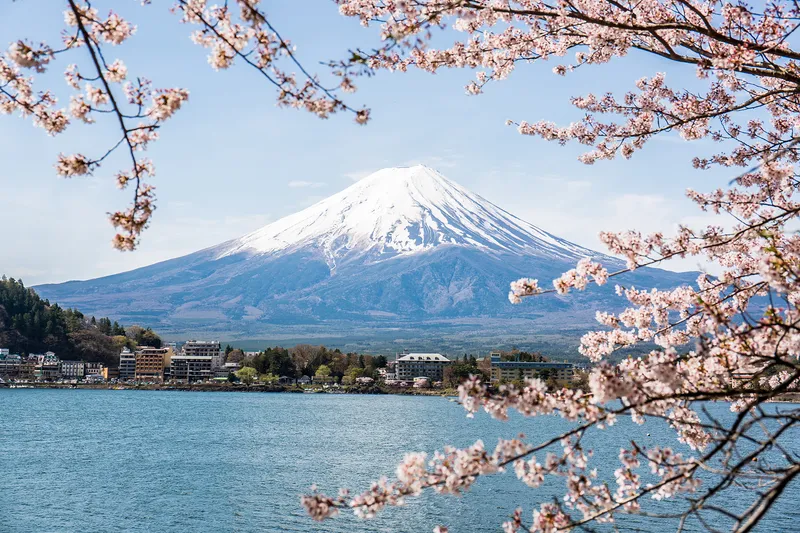
Mount Fuji nestled in the serene waters of Lake Kawaguchiko
Take a scenic boat ride on the lake to enjoy the stunning views of Mt. Fuji, or ride the Mt. Fuji Panorama Ropeway for panoramic views. You may also visit the Arakurayama Sengen Park and Chureito Pagoda, or explore the Oshino Hakkai open-air museum for a sneak peek into traditional Japanese life.
For food, one must try the lavender ice cream at Kawaguchiko Herb Studio. The ice cream is topped with real edible flowers, coated in sugar, making it a unique and delicious experience.
Oshino Hakkai
Oshino-Hakkai is renowned for its eight crystal-clear ponds, fed by snowmelt from the slopes of Mount Fuji. The water takes over 80 years to filter through the mountain’s porous lava layers.
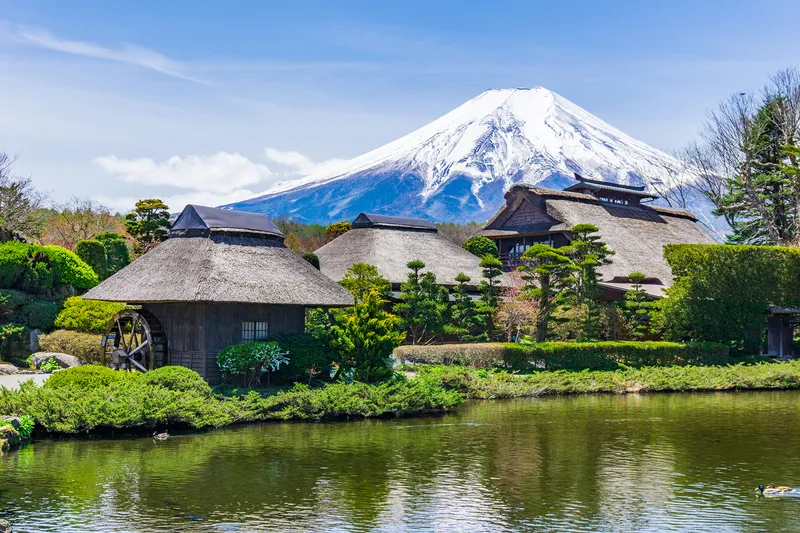
The pristine ponds of Oshino Hakkai
While strolling down the well-known street in the small village of Oshino, don’t forget to try Nori-Senbei—heart-shaped jumbo soy sauce-flavoured rice crackers wrapped with sheets of seaweed, for an added a unique local flavour to your visit.
Additionally, visit local restaurants to savour delicacies, explore souvenir shops for unique mementos, and food stands offering traditional snacks. And ofcourse, try the cold, clear Mt. Fuji volcanic rock filtered water from the springs!
Imamiya Tea Field
No trip to Japan is complete without matcha tea. Imamiya (or Obuchi Sasaba) in Fuji City, Shizuoka Prefecture, is famous as a photo spot of tea plantations where you can catch the mountain standing among the well-trimmed tea trees, lined vertically and horizontally, creating a stunning visual effect. It is also often referred to as ‘Mt. Fuji sitting on a green cushion.’
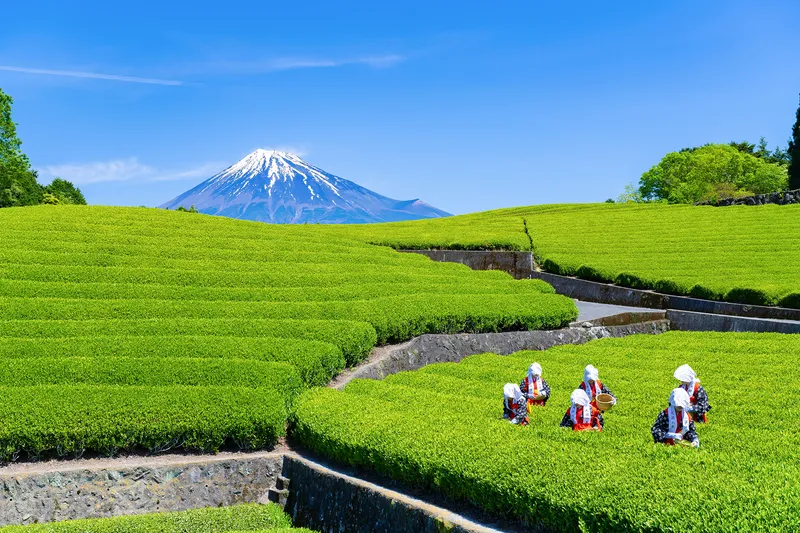
The lush rows of Imamiya Tea Field
Take a leisurely walk through the fields, or learn about the tea production—an integral part of Japan's tea culture. Preferred time of visit would be around the spring season, while the tea leaves are still fresh and contrast with the snow on Mount Fuji.
Hikawa Clock Shop
The Hikawa Clock Shop, located near Lake Kawaguchiko in Japan, is a go-to destination for clock enthusiasts and history buffs alike. The shop offers a wide selection of intricate clocks, ranging from antique timepieces to modern designs.
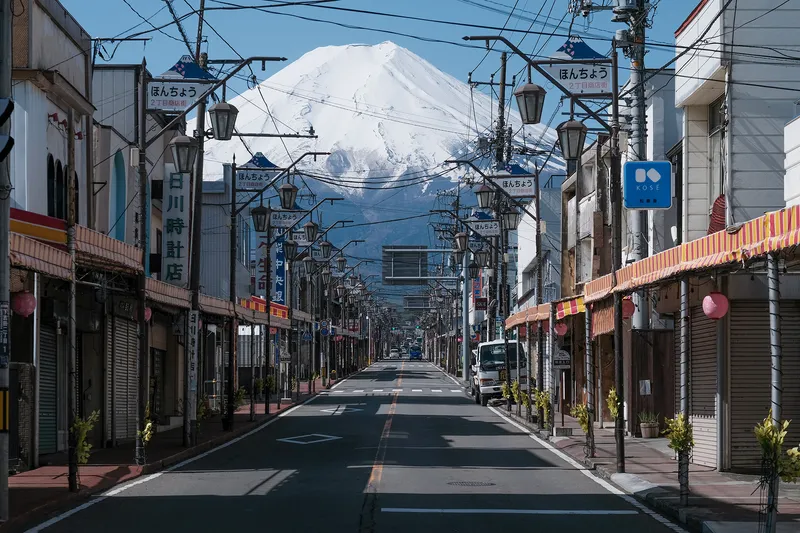
The charming facade of Hikawa Clock Shop
The shop, which has been in operation for over 70 years, has an extensive collection of clocks from various countries, showcasing different styles, artistic designs, and mechanisms.
But what’s more interesting is the picturesque street that leads to a background view of Mt Fuji in the centre, as you stroll along the cafes and shops — making it a perfect blend of old-world charm and the breathtaking backdrop of the mountain. Stand next to Mount Fuji in "Tiantai Town" to click a picture with Shōwa style!
For the uninitiated, the Showa style refers to a fusion of Japanese and Western fashion and design that emerged in Japan during the Showa era (1926-1989), particularly in the interwar period.
Akakurayama Sengen Park
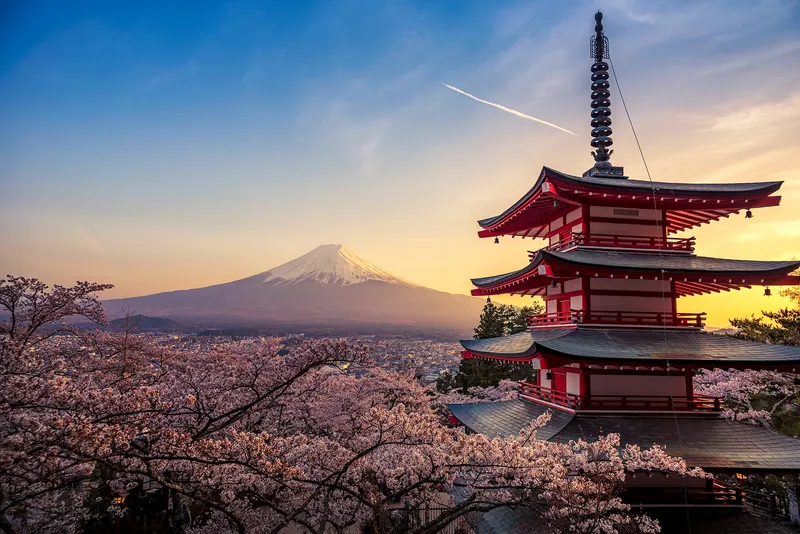
Akakurayama Sengen Park, a perfect blend of natural beauty and cultural charm
After climbing 398 steps at the base of Mount Arakurayama, travellers can finally reach the observation deck that looks out over the cityscape of Fujiyoshida City and majestic Mt. Fuji towering above. Though the Spring sakura (cherry blossom) season is one of the best views, the Arakura Sengen Shrine and its five-storied pagoda next to the active volcano will resemble nothing less than a movie scene.
Stay hydrated during the climb, buy hand-painted postcards and just enjoy the view—it’s worth it.
Edited by Affirunisa Kankudti







